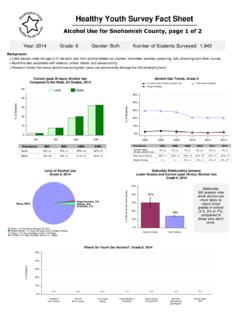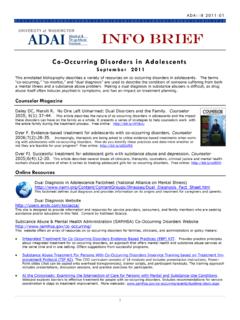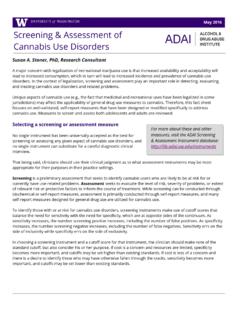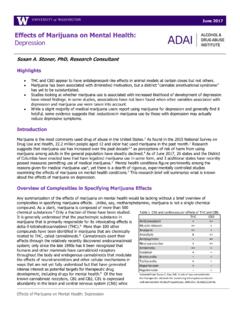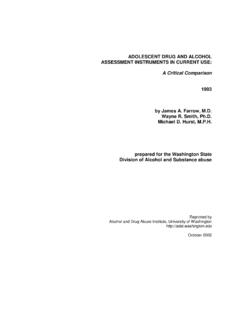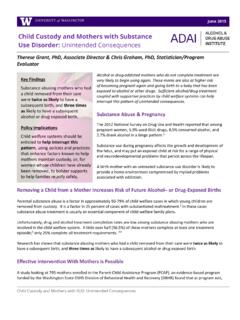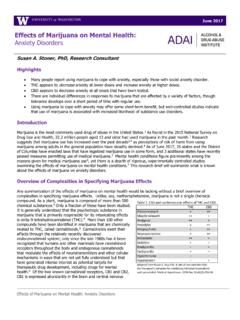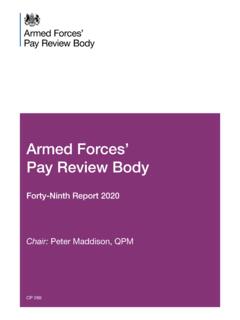Transcription of Effects of Marijuana on Mental Health: Bipolar Disorder
1 Effects of Marijuana on Mental Health: Bipolar Disorder June 2017 Effects of Marijuana on Mental Health: Bipolar Disorder Considering Locked vs. Unlocked Treatment Facilities Susan A. Stoner, PhD, Research Consultant Highlights Marijuana use and cannabis use disorders are markedly more prevalent among persons with Bipolar spectrum disorders compared to the general population or persons with any Mental illness. Although BD is not listed as a qualifying condition for medical Marijuana in any state,34 anecdotal reports suggest some individuals use Marijuana to treat symptoms of BD. Marijuana use or use Disorder is associated with worsened affective episodes, psychotic symptoms, rapid cycling, suicide attempts, decreased long-term remission, poorer global functioning, and increased disability. Bipolar patients who stop using Marijuana during manic/mixed episode have similar clinical and functional outcomes to those who never use Marijuana , while continued use is associated with higher risk of recurrence and poorer functioning.
2 Introduction Marijuana is the most commonly used drug of abuse in the United As found in the 2015 National Survey on Drug Use and Health, million people aged 12 and older had used Marijuana in the past Research suggests that Marijuana use has increased over the past decade2-4 as perceptions of risk of harm from using Marijuana among adults in the general population have steadily As of June 2017, 26 states and the District of Columbia have enacted laws that have legalized Marijuana use in some form, and 3 additional states have recently passed measures permitting use of medical Mental health conditions figure prominently among the reasons given for medical Marijuana use6, yet there is a dearth of rigorous, experimentally controlled studies examining the Effects of Marijuana on Mental health This research brief will summarize what is known about the Effects of Marijuana on Bipolar Disorder (BD), a chronic mood Disorder that involves the experience of one or more manic or hypomanic episodes, which can be accompanied by a major depressive episode.
3 Manic episodes are characterized by an elevated, expansive, or irritable mood lasting for at least 1 week while hypomanic episodes are characterized by less severe symptoms of a manic episode lasting for at least 4 days. Major depressive episodes are characterized by depressed mood for at least 2 weeks. In a mixed episode are symptoms of both mania and depression occur simultaneously or in rapid succession. BD includes Bipolar I Disorder (BD-I, manic episodes usually alternating with a depressive episode), Bipolar II Disorder (BD-II, alternating hypomanic and depressive episodes), cyclothymia (subsyndromal hypomanic and depressive symptom phases), and Bipolar Disorder not otherwise specified (BD-NOS, clinically significant symptoms of BD that do not meet criteria for other BD diagnoses).8 Overview of Complexities in Specifying Marijuana Effects Any summarization of the Effects of Marijuana on Mental health would be lacking without a brief overview of complexities in specifying Marijuana Effects .
4 Unlike, say, methamphetamine, Marijuana is not a single chemical compound. As a plant, Marijuana is composed of more than 500 chemical Only a fraction of these have been studied. It is generally understood that the psychotropic substance in Marijuana that is primarily responsible for its intoxicating Effects is delta-9-tetrahydrocannabinol (THC).9 More than 100 other compounds have been identified in Marijuana that are chemically related to THC, called Cannabinoids exert their Effects through the Effects of Marijuana on Mental Health: Bipolar Disorder 2 | P a g e relatively recently discovered endocannabinoid system; only since the late 1980s has it been recognized that humans and other mammals have cannabinoid receptors throughout the body and endogenous cannabinoids that modulate the Effects of neurotransmitters and other cellular mechanisms in ways that are not yet fully understood but that have generated intense interest as potential targets for therapeutic drug development, including drugs for Mental Of the two known cannabinoid receptors, CB1 and CB2, CB1 is expressed abundantly in the brain and central nervous system (CNS) while CB2 expression is low in the CNS but high in peripheral immune cells and Psychoactive Effects of Marijuana are attributed to CB1 receptors whereas CB2 receptors are , 10 Aside from THC, the most studied phytocannabinoid is cannabidiol (CBD).
5 11 CBD has been described as nonpsychotropic due to the fact that it appears to be non-intoxicating and non-reinforcing, but it does appear to be psychotropic insofar as it appears to have pharmacological benefits with regard to anxiety, schizophrenia, addiction, and Table 1 summarizes the major CNS and cardiovascular Effects of THC and CBD has been demonstrated to attenuate certain Effects of THC, including intoxication, sedation, and In modern clinical trials, this has permitted the administration of higher doses of THC in an effort maximize therapeutic Effects while minimizing side It is largely unknown how the interaction of THC and CBD plays out in practical use of Marijuana by medicinal and recreational Marijuana users. Research on cannabis products seized by the US Drug Enforcement Agency (DEA) shows that the potency of Marijuana in common use has increased dramatically in the last 2 decades, at least in terms of THC As shown in Figure 1, from 1995 to 2014, the average THC content of seized cannabis products virtually tripled from approximately 4% to approximately 12%.
6 8 On the other hand, average CBD content fell from approximately in 2001 to < in 2014, resulting in a change in the THC:CBD ratio of 14:1 in 1995 to approximately 80:1 in This means that, on average, the cannabis products seized in 2014 were presumably far more intoxicating and than those seized in 1995 and Marijuana and cannabis products that are in common use may bear little resemblance to Marijuana supplied by the federal government for Marijuana In terms of strength, the National Institute on Drug Abuse considers less than 1% to be low, 1-5% to be medium, 5-10% to be high, and over 10% to be very An examination of the online menu of one of Seattle s most popular recreational Marijuana stores in June 2017 listed over 100 varieties of Marijuana flowers that were labeled as 20% THC or higher, with THC content going as high as 30%. For many of these, CBD content was not listed. By comparison, there were only 20 varieties with listed THC content under 10%.
7 Marijuana concentrates were labeled as having THC content as high as 97%. From a scientific standpoint, the Effects of cannabis products with such levels of THC on Mental health have largely not been studied. Individual differences in objective and subjective Effects of Marijuana vary by individual, variety/strain, dosage, route of administration, personality, degree of tolerance, and other Many of the psychological Effects of cannabis Effects of Marijuana on Mental Health: Bipolar Disorder 3 | P a g e and THC are biphasic and Acute Marijuana intoxication is generally associated with euphoria, subjective quickening of associations, relaxation, decreased motor activity, a sense of calm, increased awareness of sensory experience and internal sensations of the body , transient sensory experiences, synesthesia, craving sweet and salty foods, enhanced perception of current activities, increased salience of stimuli, simultaneous focus on multiple things, impaired shifting of focus, fantasies of power, and belief of having arrived at a transcendent With regard to neurocognition, Marijuana intoxication is associated with deficits in processing speed, attention, working memory, decision-making, motivation, time-perception, and reality Considering the broad range of Effects , one can begin to imagine how Marijuana could have beneficial or harmful Effects with regard to Mental health.
8 Tolerance to certain Effects of Marijuana develops with regular use, within several days in some cases,9 as a function of CB1 receptor expression Research suggests that after tolerance develops it can take several weeks of THC-free recovery for CB1 receptor expression to return to baseline Because of tolerance, the eventual downregulation of CB1 receptors with chronic use means that any benefit derived from THC with regard to Mental health could result in symptom exacerbation when users are not under the influence of Prevalence of Marijuana Use and Use Disorders in Bipolar Disorder Among individuals with Mental illness, persons with BD are particularly likely to use Marijuana and to have a cannabis use Disorder (CUD). In an analysis of data from a nationally representative survey of 43,070 respondents aged 18 and older conducted from 2001 to 2002 (the National Epidemiologic Survey on Alcohol and Related Conditions) Lev-Ran et found that, as shown in Figure 2, compared to those without Mental illness or with any Mental illness, rates of Marijuana use and CUDs were highly variable among those with BD and particularly elevated among those with BD-I.
9 The researchers estimated that approximately 10% of those with BD-I in in their study had a CUD or used Marijuana at least weekly and noted this is lower than rates of CUDs among those with BD found in other studies, which are as high as 50%.18 They suggest differences in prevalence rates may be due to differences in definitions and methods as well as possible under-reporting of substance use in surveys conducted by government agencies. However, studies consistently find that those with BD have among the highest rates of Marijuana use of those with Mental Influence of Marijuana Use on the Course of Bipolar Disorder The influence of Marijuana use on the course of BD has been examined in three Marijuana use is associated with earlier age of onset of BD,19 prolonged or worsened manic episodes,20 and increased likelihood of suicide A study of patients over a one year follow-up period after their first treatment for BD-I found that continued Marijuana use was associated with elevated mood, which in turn was associated with poorer global functioning.
10 These relationships were not explained by differences in age, gender, premorbid functioning or baseline symptoms. A study conducted in Australia found that Marijuana use was associated with decreased likelihood of long-term remission in Interestingly, the nature of the association depended on gender and medication type. Specifically, Marijuana use was associated with lower remission rates for depressive symptoms in women and for manic symptoms in men. Furthermore, remission rates for depressive symptoms were lower in cannabis users prescribed mood stabilizers alone, whereas remission rates for manic symptoms were lower in cannabis users prescribed olanzapine. The researchers note this may indicate that Marijuana may diminish the effect of medications used to treat BD. For Effects of Marijuana on Mental Health: Bipolar Disorder 4 | P a g e example, as smoked Marijuana is believed to induce hepatic CYP 1A2 enzyme activity, systemic Effects of CYP 1A2 substrates, such as olanzapine, may be decreased in individuals who smoke CUDs in those with BD are associated with a number of poor treatment outcomes, including increased disability and mixed episodes,24 in creased manic, depressive, and psychotic symptoms,25, 26 low compliance, 25 and rapid cycling,27 One study noted a common effect of a psychiatric hospitalization for mania on the course of CUD.
